Related Research Articles

The Yangshao culture was a Neolithic culture that existed extensively along the middle reaches of the Yellow River in China from around 5000 BC to 3000 BC. The culture is named after the Yangshao site, the first excavated site of this culture, which was discovered in 1921 in Yangshao town, Mianchi County, Sanmenxia, western Henan Province by the Swedish geologist Johan Gunnar Andersson (1874–1960). The culture flourished mainly in the provinces of Henan, Shaanxi and Shanxi.

The Longshanculture, also sometimes referred to as the Black Pottery Culture, was a late Neolithic culture in the middle and lower Yellow River valley areas of northern China from about 3000 to 1900 BC. The first archaeological find of this culture took place at the Chengziya Archaeological Site in 1928, with the first excavations in 1930 and 1931. The culture is named after the nearby modern town of Longshan in Zhangqiu, Shandong. The culture was noted for its highly polished black pottery. The population expanded dramatically during the 3rd millennium BC, with many settlements having rammed earth walls. It decreased in most areas around 2000 BC until the central area evolved into the Bronze Age Erlitou culture. The Longshan culture has been linked to the early Sinitic . According to the area and cultural type, the Longshan culture can be divided into two types: Shandong Longshan and Henan Longshan. Among them, Shandong Longshan Cultural Site includes Chengziya Site; Henan Longshan Cultural Site includes Dengfeng Wangchenggang Site in Wangwan, Taosi Site and Mengzhuang Site in Hougang.
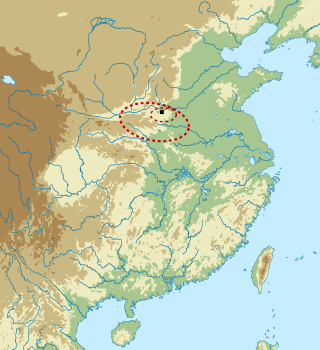
The Erlitou culture was an early Bronze Age society and archaeological culture. It existed in the Yellow River valley from approximately 1900 to 1500 BC. The culture is named after Erlitou, an archaeological site in Yanshi, Henan. It was widely spread throughout Henan and Shanxi and later appeared in Shaanxi and Hubei. Most archaeologists consider Erlitou the first state-level society in China. Chinese archaeologists generally identify the Erlitou culture as the site of the Xia dynasty, but there is no firm evidence, such as writing, to substantiate such a linkage, as the earliest evidence of Chinese writing dates to the late Shang dynasty.

The Dawenkou culture was a Chinese Neolithic culture primarily located in the eastern province of Shandong, but also appearing in Anhui, Henan and Jiangsu. The culture existed from 4300 to 2600 BC, and co-existed with the Yangshao culture. Turquoise, jade and ivory artefacts are commonly found at Dawenkou sites. The earliest examples of alligator drums appear at Dawenkou sites. Neolithic signs, perhaps related to subsequent scripts, such as those of the Shang dynasty, have been found on Dawenkou pottery. Additionally, the Dawenkou practiced dental ablation and cranial deformation, practices that disappeared in China by the Chinese Bronze Age.

The Majiayao culture was a group of neolithic communities who lived primarily in the upper Yellow River region in eastern Gansu, eastern Qinghai and northern Sichuan, China. The culture existed from 3300 to 2000 BC. The Majiayao culture represents the first time that the upper Yellow River region was widely occupied by agricultural communities and it is famous for its painted pottery, which is regarded as a peak of pottery manufacturing at that time.

The Hemudu culture was a Neolithic culture that flourished just south of the Hangzhou Bay in Jiangnan in modern Yuyao, Zhejiang, China. The culture may be divided into early and late phases, before and after 4000 BC respectively. The site at Hemudu, 22 km northwest of Ningbo, was discovered in 1973. Hemudu sites were also discovered at Tianluoshan in Yuyao city, and on the islands of Zhoushan. Hemudu are said to have differed physically from inhabitants of the Yellow River sites to the north. Some authors propose that the Hemudu Culture was a source of the pre-Austronesian cultures.

The Qijia culture was an early Bronze Age culture distributed around the upper Yellow River region of Gansu and eastern Qinghai, China. It is regarded as one of the earliest bronze cultures in China.
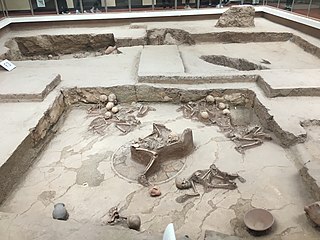
Lajia is a Bronze Age archaeological site in the upper reaches of the Yellow River, on the border between the Chinese provinces of Gansu and Qinghai. As at other sites of the Qijia culture, the people of Lajia had an agricultural economy based primarily on millet cultivation and sheep herding. They also kept pigs for use in ritual activities, including making oracle bones, and experimented with a high temperature-fired pottery described as proto-porcelain. The world's oldest known noodles were discovered at the site in 2005.
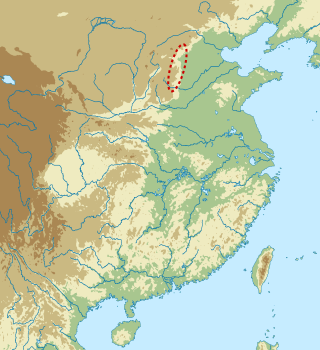
The Cishan culture was a Neolithic culture in northern China, on the eastern foothills of the Taihang Mountains. The Cishan culture was based on the farming of broomcorn millet, the cultivation of which on one site has been dated back 10,000 years. The people at Cishan also began to cultivate foxtail millet around 8700 years ago. However, these early dates have been questioned by some archaeologists due to sampling issues and lack of systematic surveying.
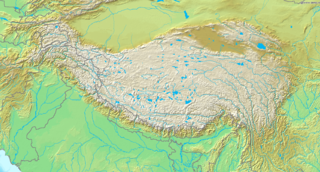
The Karuo culture was a Neolithic culture in Tibet. The culture cultivated foxtail millet.
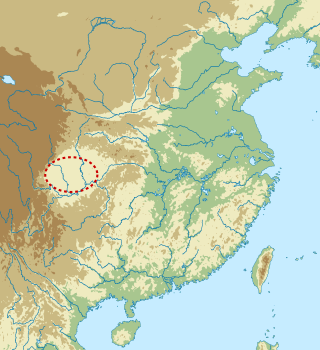
The Baodun culture was a Neolithic culture centered on the Chengdu Plain in Sichuan, China.

The Shijiahe culture was a late Neolithic culture centered on the middle Yangtze River region in Shijiahe Town, Tianmen, Hubei Province, China. It succeeded the Qujialing culture in the same region and inherited its unique artefact of painted spindle whorls. Pottery figurines and distinct jade worked with advanced techniques were also common to the culture.

The Houli culture was a Neolithic culture in Shandong, China. The people of the culture lived in square, semi-subterranean houses. The most commonly found artefacts at Houli sites are pottery and stone tools. Jade artefacts and bone, antler, shell tools were also found at Houli sites. While the remains of domesticated dogs and pigs in the early stages of domestication were found at some sites associated with the culture, the people of the Houli culture relied mostly on hunting and fishing. The remains of rice, broomcorn millet, and foxtail millet were discovered at Houli sites.
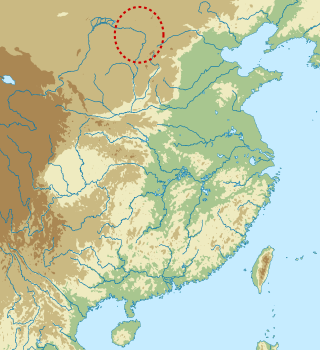
The Zhukaigou culture was a late Neolithic and early Bronze Age culture centered in the Ordos Plateau of Inner Mongolia, China. The type site at Zhukaigou was discovered in Ejin Horo Banner, Inner Mongolia, and excavated from 1977 to 1984. Zhukaigou culture is a reputed progenitor of the Ordos bronze culture and accordingly a first "Northern Zone" culture, extending to northern and central Inner Mongolia, northern Shaanxi, and northern Shanxi, with the Ordos region at its center. Transition to metalworking is dated to around the end of the third millennium BCE, at the same time was attained a higher level in the ceramic. Zhukaigou culture lasted to c. 1500 BCE.
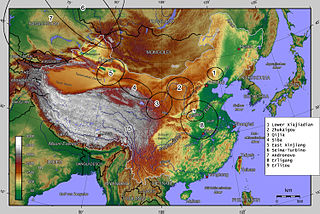
The Lower Xiajiadian culture is an archaeological culture in Northeast China, found mainly in southeastern Inner Mongolia, northern Hebei, and western Liaoning, China. Subsistence was based on millet farming supplemented with animal husbandry and hunting. Archaeological sites have yielded the remains of pigs, dogs, sheep, and cattle. The culture built permanent settlements and achieved relatively high population densities. The population levels reached by the Lower Xiajiadian culture in the Chifeng region would not be matched until the Liao Dynasty. The culture was preceded by the Hongshan culture, through the transitional Xiaoheyan culture. The type site is represented by the lower layer at Xiajiadian in Chifeng, Inner Mongolia.

The Siba culture, also called Huoshaogou culture (火烧沟), was a Bronze Age archaeological culture that flourished circa 1900 to 1500 BC in the Hexi Corridor, in Gansu Province of Northwest China. It was discovered in 1984 at Sibatan in Shandan County. Siba type pottery vessels are different from the others in Gansu. Siba produced painted pottery with coloured decorations; these were painted after the vessels had been fired. Similar pottery was used by the Tianshanbeilu culture at Hami basin to the west.
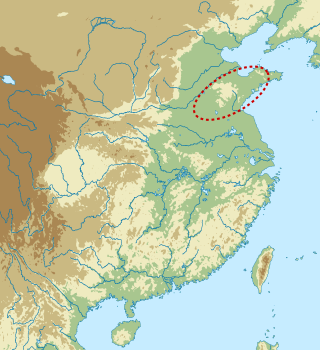
The Yueshi culture was an archaeological culture in the Shandong region of eastern China, dated from 1900 to 1500 BC. It spanned the period from the Late Neolithic to the early Bronze Age. In the Shandong area, it followed the Longshan culture period and was later replaced by the Erligang culture.

The Liao Civilization or Liao River Civilization, named after the Liao River, is an umbrella term for several ancient civilizations that originated in the Liao basin. It is thought to have first formed in 6,200 BC. This civilization was discovered when Ryuzo Torii, a Japanese archaeologist, discovered the Hongshan culture in 1908.
Xituanshan is a Late Bronze Age group of stone burials in Jilin, China. It was designated a Major National Historical and Cultural Site by the Chinese government in 2001.
References
Citations
- ↑ Liu et al. 2015, p. 1.
- 1 2 3 Liu, Fuller & Jones 2015, p. 346.
- ↑ Liu & Chen 2012, p. 83.
- ↑ Lee et al. 2007, p. 1087–1092.
- 1 2 3 Liu, Fuller & Jones 2015, p. 337.
- 1 2 3 4 Liu et al. 2015, p. 2.
- ↑ "A peculiar pottery figure was discovered at the Xinglonggou site, Inner Mongolia". Chinese Archaeology. Chinese Archaeology.
- 1 2 3 4 Liu, Fuller & Jones 2015, p. 338.
- ↑ Liu, Fuller & Jones 2015, p. 337, 343.
- ↑ Liu, Fuller & Jones 2015, p. 343-344.
- ↑ Liu, Fuller & Jones 2015, p. 344.
- ↑ Liu et al. 2012, p. 2.
- 1 2 Liu, Fuller & Jones 2015, p. 342.
- ↑ Liu, Fuller & Jones 2015, p. 343.
- ↑ Liu et al. 2015.
- ↑ Liu et al. 2015, p. 6.
- ↑ Liu et al. 2015, p. 12.
- 1 2 3 Liu, Fuller & Jones 2015, p. 349.
- ↑ Zhao 2011.
- ↑ "A peculiar pottery figure was discovered at the Xinglonggou site, Inner Mongolia". Chinese Archaeology. Chinese Archaeology.
- 1 2 Liu, Fuller & Jones 2015, p. 345.
- ↑ Liu, Fuller & Jones 2015, p. 345-346.
- ↑ Liu, Xinyi; Zhao, Zhijun; Liu, Guoxiang (2015). "Xinglonggou, China". The Cambridge World History: Volume 2: A World with Agriculture, 12,000 BCE–500 CE. Cambridge University Press. pp. 346–347, Fig.13.7 "Terracotta statue recovered at Xinglonggou I I". ISBN 978-0-521-19218-7.
- 1 2 Liu & Chen 2012, p. 176.
- 1 2 3 Liu, Fuller & Jones 2015, p. 350.
- ↑ "A peculiar pottery figure was discovered at the Xinglonggou site, Inner Mongolia". Chinese Archaeology. Chinese Archaeology.
- ↑ Liu & Chen 2012, p. 88-89.
- ↑ Liu & Chen 2012, p. 84.
- ↑ Liu, Fuller & Jones 2015, p. 351-352.
- ↑ Liu et al. 2012, p. 7.
Bibliography
- Lee, Gyoung-Ah; Crawford, Gary W.; Liu, Li; Chen, Xingcan (2007). "Plants and people from the Early Neolithic to Shang periods in North China". Proceedings of the National Academy of Sciences. 104 (3): 1087–1092. Bibcode:2007PNAS..104.1087L. doi: 10.1073/pnas.0609763104 . ISSN 0027-8424. PMC 1764861 . PMID 17213316.
- Liu, Li; Chen, Xingcan (2012). The Archaeology of China: From the Late Paleolithic to the Early Bronze Age. Cambridge University Press. ISBN 978-0-521-64310-8.
- Liu, Xinyu; Fuller, Dorian Q.; Jones, Martin (2015). "Chapter 13: Xinglonggou, China". In Barker, Graeme; Goucher, Candice (eds.). The Cambridge World History. Vol. 2: A World with Agriculture, 12, 000 BCE–500 CE. Cambridge: Cambridge University Press. pp. 335–352. ISBN 978-0-521-19218-7.
- Liu, Xinyi; Jones, Martin K.; Zhao, Zhijun; Liu, Guoxiang; O'Connell, Tamsin C. (2012). "The earliest evidence of millet as a staple crop: New light on neolithic foodways in North China". American Journal of Physical Anthropology. 149 (2): 283–290. doi:10.1002/ajpa.22127. ISSN 0002-9483. PMID 22961368.
- Liu, Li; Duncan, Neil A; Chen, Xingcan; Liu, Guoxiang; Zhao, Hao (2015). "Plant domestication, cultivation, and foraging by the first farmers in early Neolithic Northeast China: Evidence from microbotanical remains". The Holocene. 25 (12): 1965–1978. Bibcode:2015Holoc..25.1965L. doi:10.1177/0959683615596830. ISSN 0959-6836. S2CID 126933348.
- Zhao, Zhijun (2011). "New Archaeobotanic Data for the Study of the Origins of Agriculture in China". Current Anthropology. 52 (S4): S295–S306. doi:10.1086/659308. ISSN 0011-3204. S2CID 144894976.